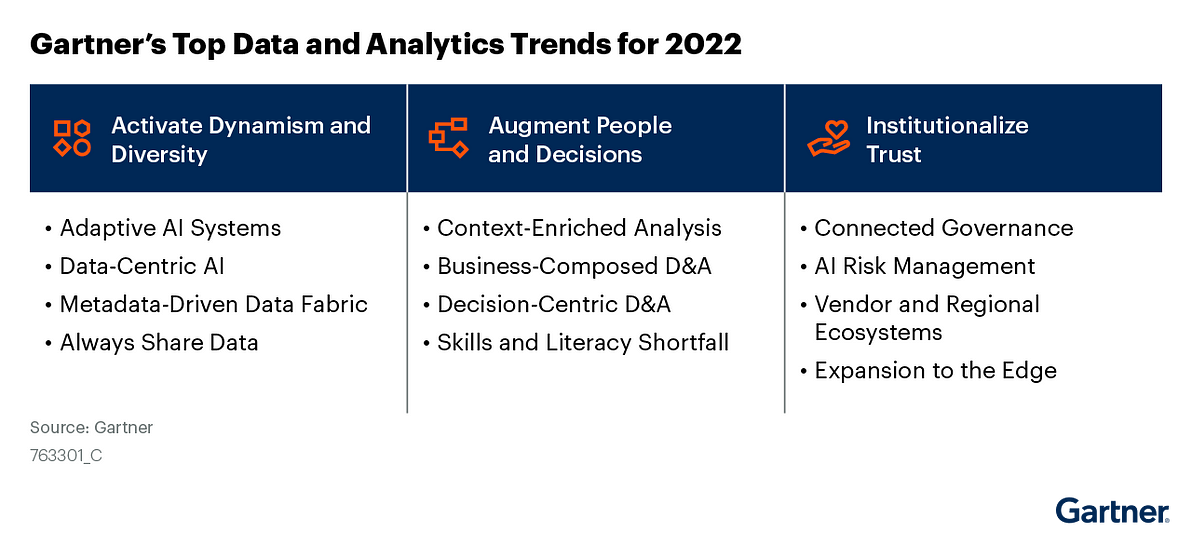By 2024, organizations that lack a sustainable data and analytics operationalization framework will have their initiatives set back by up to two years.
Traditional data management is ripe for disruption, to support AI efforts.
This is an excerpt of the publication below, with the title above, focusing on the topic in question. For the full version of the article, please, refer to the original publication.
Gartner
Top Trends in Data and Analytics, 2022
By Rita Sallam, Ted Friedman, and 37 more
11 March 2022
Excerpt by
Joaquim Cardoso MSc.
The Health Revolution
Multidisciplinary Institute for Better Health for All
May 27, 2022
Top Trends in Data and Analytics
The top D&A trends represent business, market and technology dynamics that you cannot afford to ignore

They have the potential to transform your enterprise, and will accelerate in their adoption over the next three years.
You should decide whether to proactively monitor, experiment with or aggressively invest in key trends based on their urgency and alignment to strategic priorities.
The top D&A trends and technologies do not exist in isolation; they build on and reinforce one another.
We have selected our trends for 2022 in part based on their combined effects. Taken together, our top data and analytics technology trends for 2022 will help you meet your organization’s top strategic priorities to anticipate, adapt and scale value.
This, in turn, will enable you to encourage innovation and put in place success metrics and incentives that emphasize learning and reward innovation.
Top Trends in Data and Analytics
- Group 1: Activate Dynamism and Diversity
- Group 2: Augment People and Decisions
- Group 3: Institutionalize Trust

Group 1: Activate Dynamism and Diversity
- Adaptive AI Systems
- Data-Centric AI
- Metadata-Driven Data Fabric
- Always Share Data

2.Data-Centric AI
Analysis by: Svetlana Sicular, Ted Friedman, Mike Fang, Erick Brethenoux
SPA:
By 2024, organizations that lack a sustainable data and analytics operationalization framework will have their initiatives set back by up to two years.
By 2024, organizations that lack a sustainable data and analytics operationalization framework will have their initiatives set back by up to two years.
Description:
Data-centric AI disrupts traditional data management and prevalent model-centric data science by addressing AI-specific data considerations, such as data bias, labeling and drift, in order to improve the quality of models on an ongoing basis.
Why Trending:
- The AI community is facing a bifurcation of “model-centric” and “data-centric” AI, because data quality and consistency improve AI accuracy more efficiently than tweaking models.
- Most commonly delivered AI solutions depend on data availability, quality and understanding, not just AI model building.
However, many enterprises attempt to tackle AI without considering AI-specific data management issues.
The importance of data management in AI is often underestimated. - Traditional data management is ripe for disruption, to support AI efforts. Without the right data, building AI is risky and possibly dangerous. In most organizations, AI-specific considerations, such as data bias, diversity and labeling, are addressed haphazardly.
- The AI community remains largely oblivious to data management capabilities, practices and tools that can greatly benefit AI development and deployment.
- AI reflects and amplifies bias originating in the choice of algorithms, data interpretation and labeling, and human bias recorded in the data.
Bias mitigation is an acute, AI-specific problem.
People interpret data, curate it and put algorithms and data together.
For this reason, AI-centric risk management, including data governance, is also a related trend.
Traditional data management is ripe for disruption, to support AI efforts.
Implications:
- Data-centric AI is evolving, and should include relevant data management disciplines, techniques and skills, such as data quality, data integration and data governance, which are foundational capabilities for scaling AI.
- Data management activities don’t end once the model has been developed. Deployment considerations and ongoing monitoring of the relevance of the model require dedicated data management activities and practices.
- Organizations that invest in AI at scale will shake up their data management practices and capabilities to preserve the evergreen classical ideas and extend them to AI by making them AI-centric in two ways:
– Add capabilities necessary for convenient AI development by an AI-focused audience that is not familiar with data management.
– Use AI to improve and augment evergreen classics of data governance, persistence, integration and data quality.
For example, by making augmented classical profiling, cleansing, visualization and entity resolution available to AI teams. - Leading enterprises are building out data fabric and active metadata, while the tooling for data management is about to be reinvented.
They must decide what to build themselves now, and what to wait for.
For example, enterprises are aggressively implementing graphs and extending their governance to AI.
Recommendations:
Data and analytics leaders should:
- Formalize data-centric AI and AI-centric data as part of your data management strategy.
Implement active metadata and data fabric as a key foundational component of this strategy. - Leverage an ecosystem of AI-centric data management capabilities that combine traditional and new capabilities to prepare the enterprise for the era of decision intelligence.
- Promulgate policies about data fitness for AI.
Define and measure minimum standards, such as formats, tools, metrics, etc., for AI-centric data early on.
This will prevent the need to reconcile multiple data approaches when you take AI to scale. - Seek diversity of data, algorithms and people to ensure AI value and ethics.
- Establish roles and responsibilities to manage data in support of AI. Leverage AI engineering and data management expertise and approaches to support ongoing deployment and production uses of AI.
Include data management requirements when deploying models.
Originally published at https://www.gartner.com












